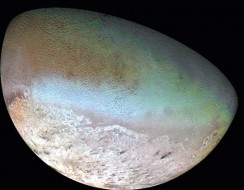Here’s an opportunity for amateurs to help improve our understanding of Neptune’s moon Triton.

In the early evening of Thursday, October 5th, Neptune’s large satellite Triton will occult the 12th-magnitude star UCAC4 410-143659.
The star, which is about a magnitude brighter than Triton, is the brightest to be blocked by Triton since 1997, giving us a rare opportunity to study the Pluto-like moon’s atmosphere. The occultation occurs around 7:55 p.m. EDT, when Neptune/Triton will be about 25° above the horizon in the southeast as seen from the Eastern coast of the United States.
Farther west, the event occurs during nautical twilight so there won’t be a lot of dark time to get on target. Fortunately, you only need to find 8th-magnitude Neptune, which in turn is only half a degree south of 3.7-magnitude Lambda Aquarii. Once spotted in your finder scope, Triton will be located in the same direction relative to the horizon when the occultation occurs. Use Sky & Telescope's Triton tracker to help identify the moon.
Lambda Aquarii can be found by extending the west side of the Square of Pegasus (marked by Scheat and Markab) south by almost twice its distance; Lambda is also 10° south of the distinctive Y-shaped “Water Jug.” You can see these views, and more detailed ones to find Neptune, on the annotated charts of different scales here.
How to Photograph the Occultation (and Aid Science)
Amateurs interested in recording the event should use a camera capable of recording single frames that can then be calibrated using (at the very least) flats and bias frames. Although the event will be visible in telescopes with apertures smaller than 8 inches, you’ll need exposures of several seconds to ensure a strong signal-to-noise ratio. Larger scopes that can record the 12.5-magnitude star in exposures shorter than 1-second can forgo dark calibration, although flats and bias frames are always recommended to produce the best photometric measurements.
To ensure you get the brightest signal, shoot without any additional filters in place. Additionally, the mid-point of the occultation isn’t precisely known, so imagers targeting this event should start recording at least 10 minutes before the predicted time and continue for 10 minutes afterwards. Your system should be able to image Triton with enough magnification to give some dark space between the planet and its moon.
If you’re recording the event with a video device, the recording needs to be accurately timed, such as with an IOTA-VTI or similar GPS-based time inserter, with as fast a cadence as allows recording Triton, preferably half a second or less. More information about the event is available at https://hubble.mit.edu/.
The predicted centerline of visibility crosses Florida, where observers have a good chance to observe a “central flash” when the moon’s atmosphere focuses the star’s light. Images of this flash can help to probe deeper into Triton’s atmosphere. Several mobile telescopes will be deployed in Florida, and SOFIA (Stratospheric Observatory for Infrared Astronomy) plans to record the central flash over the Atlantic Ocean.
The occultation is also visible from western Europe, and many will be trying to record it there, though more observations are needed from the U.S. If you don’t have access to Occult Watcher (click on the link for a free download) for uploading your observing details, please send your occultation observing location to David Dunham of the IOTA. This will ensure that those with mobile telescopes can avoid your area and thereby obtain the best coverage of the event.
Read here on how the space-based Gaia mission helped prepare for the event.
 0
0
Comments
You must be logged in to post a comment.